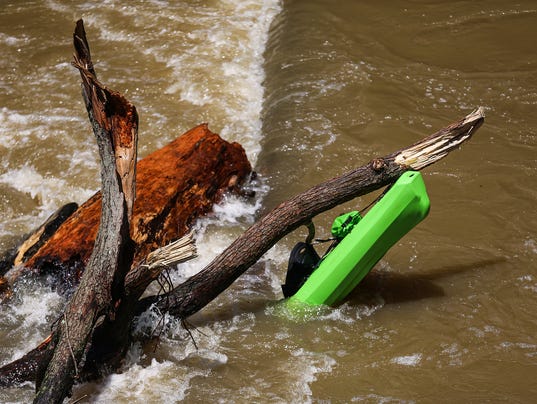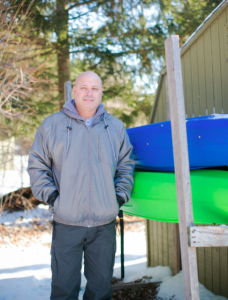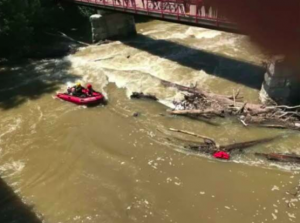Indianapolis Fire Department public information officer Rita Reith shares an update on two kayakers who remain in critical condition after being rescued from the White River near the Broad Ripple Dam, Indianapolis, Sunday, July 9, 2017. Jenna Watson/IndyStar
 Buy Photo
Buy Photo
(Photo: Jenna Watson/IndyStar)
Update, 6:30 p.m. July 10: One of two kayakers pulled from the White River Sunday has died, according to IFD.
Lawrance Morrissey, 48, of Fishers, died Sunday, according to the Indianapolis Fire Department.
"He grew up in Detroit, Michigan and loved the Detroit Lions," Morrissey's family said in a prepared statement. "He also loved adventure such as warrior runs, motorcycling, kayaking, scuba diving, camping with friends and family, and was a talented artist who enjoyed oil painting. By day Lawrance was a real estate broker and by night a husband to his wife Jennifer and a father to his three beautiful children ages 14, 10, and 8 years old. He will be missed dearly by his surviving wife, kids, parents and three sisters."
The second kayaker, 54, has not yet been identified, although his condition has improved since Sunday, according to IFD.
Earlier, July 9: Two kayakers rescued from the White River Sunday afternoon have been hospitalized.
Shortly before 12:30 p.m., police and fire officials were called to the 7300 block Westfield Boulevard for a possible drowning, dispatchers confirmed.
Indianapolis Fire Department Battalion Chief Rita Reith said two kayakers were in distress on the White River at the Broad Ripple dam. "The two kayakers had come out of their boats and were stuck in what we call the boil ... the rapid churning area of the low-head dam that basically traps you and doesn't let you out," Reith said.
As crews were getting their boat into the water, the first victim was released from the boil. The fire department said firefighters threw him a rope and life jacket. He was able to grab the rope and hold on — with encouragement from people watching from the Monon Bridge above — while an off-duty firefighter grabbed bolt cutters to open the fencing and allow crews to carry the boat to the water.
They were able to pull the first victim onto the boat. He was conscious but exhausted, officials said.
Meanwhile, the second victim was stuck in the boil, unconscious. When the boat started back up stream to pass the victim to medical crews on shore, the second victim was released from the boil and floated downstream before getting stuck in a strainer underneath the Monon Bridge.
In order to get in front of the second victim, crews gunned their boat's engine, with the first victim still on board, to become airborne and jump over the strainer, officials said. The rescuers were able to speed ahead, turn the boat 180 degrees and pull the second victim on board.
 Buy Photo
Buy Photo
Cyclists and pedestrians stop along the Monon Trail, viewing the remnants of a water rescue near the Broad Ripple dam of the White River at Westfield Boulevard and 72nd Street, where the river passes below the Monon Trail in Indianapolis, Sunday, July 9, 2017. Two kayakers were in critical condition after being rescued from the "boil," a rapid churning area of the low-head dam. The force of the water pulled off the life vests that both kayakers had been wearing. (Photo: Jenna Watson/IndyStar)
Witnesses said both men, one in his 50s and one in his 40s, were wearing life vests when they first went into the water. But Reith explained that the strength of the rushing water as they were trapped in the boil pulled the vests from their bodies.
The kayakers were taken to Methodist Hospital for treatment.
"Both patients are in critical condition. One was alert and one was not," Reith said. "Very, very dangerous situation today ... this is one of those days when we're asking people not to be on the river today. Water is up well over a foot and a half, maybe two feet. The current is running about 8 knots. It's very swift water today.
"If you're not on the water, please don't get on it now."
IndyStar reporter Emma Kate Fittes contributed to this report.
Call IndyStar reporter Justin L. Mack at (317) 444-6138. Follow him on Twitter: @justinlmack.
White River Kayak Accident Survivor Warns Against Low-Head Dams
Writer: Christy Heitger-Ewing
Photographer: Jamie Sangar
 It was a bright, beautiful day last July 9 when Warren Rosenthal and his buddy, Lawrance Morrissey, decided to kayak a 15-mile stretch of the White River. Being well-versed in the dangers of low-head dams, the men planned to portage around it. It had recently rained up north, however, which caused the water to move more swiftly and carry them faster than anticipated. Within seconds, the pair found themselves going over the dam, and Rosenthal, a 3-year kayaking veteran, knew they were in trouble.
It was a bright, beautiful day last July 9 when Warren Rosenthal and his buddy, Lawrance Morrissey, decided to kayak a 15-mile stretch of the White River. Being well-versed in the dangers of low-head dams, the men planned to portage around it. It had recently rained up north, however, which caused the water to move more swiftly and carry them faster than anticipated. Within seconds, the pair found themselves going over the dam, and Rosenthal, a 3-year kayaking veteran, knew they were in trouble.
“They aren’t called drowning machines for no reason,” says Ken Smith, Assistant Director for the Division of Water with the Indiana DNR. “They’re notorious for hundreds of deaths nationwide.”
Robert Barr, IUPUI Research Scientist with the Center for Earth & Environmental Science, says that what makes these low-head dams so deadly is the hydraulic jump that occurs as the water breaks over the surface of the dam.
“It drops down and develops a gyre,” Barr says. “[It creates] a spinning like a washing machine at the bottom of that, like a circulating current.”
Rosenthal knew that survival wasn’t dependent upon his swimming skills.
“You can be Michael Phelps and you’re not swimming out of that,” Rosenthal says. “The water always wins.”
Tossed from their kayaks, the men were repeatedly churned around in the turbulent water.
“We were barely able to breathe so it was impossible to talk,” says Rosenthal, who, in a critical moment, recalled an article he’d read about finding an escape route when trapped in this specific situation. If he could curl up, dive to the bottom of the river, and swim downstream, he could emerge beyond the boil and essentially escape the riptide that kept sucking him back under. He stripped off his life jacket and took a breath.
 “Call it divine intervention, but I felt like I was pushed down into the water about 20 feet,” Rosenthal says. “I could see the water—all bubbly like it was carbonated, and the sun was shining through it, which oriented me. My first thought was, ‘I don’t know if I can hold my breath this long.’”
“Call it divine intervention, but I felt like I was pushed down into the water about 20 feet,” Rosenthal says. “I could see the water—all bubbly like it was carbonated, and the sun was shining through it, which oriented me. My first thought was, ‘I don’t know if I can hold my breath this long.’”
He’d already been furiously treading water, gasping for air, and fighting for his life for 15 minutes, leaving him utterly exhausted. He floated to the top and realized he was out of the boil and was going down river with the current. He grabbed hold of a log jam and held on until rescuers snatched him out of the river. Tragically, Morrissey perished in the accident, leaving behind a wife and three children.
Rosenthal, who has a wife, Stephanie, daughter, Sydney (17), and son, Rock (14), was in the hospital for six days. Though he didn’t sustain a single scratch, he describes the aftermath as feeling like he’d been thrashed by a team of 15 men. What he took away from the accident was a determination to spread the word about the danger of low-head dams.
Now, he meets monthly with a group called the Silver Jackets, which consists of professors, DNR employees, members of homeland security, and others who are passionate about knocking down or modifying these dams so that they no longer present a danger. Unfortunately, since it costs $150,000 to remove a low-head dam and thousands are scattered across the country (with 150 in the state of Indiana), at the very least, the Silver Jackets would like to see warning signs posted along river banks to educate and warn the public.
“It isn’t impossible to live if you get caught in the hydraulic of a low-head dam, but it’s highly unlikely,” says Lt. Terry Hyndman, Executive Officer with the Indiana DNR, Law Enforcement Division.
“I’m a rarity to have survived,” says Rosenthal, franchise owner of FibreNew, a company that provides leather, plastic and vinyl furniture restoration. He just contributed to a video segment for WFYI that’s geared toward 18- to 24-year-olds — the age group that’s most susceptible to perishing from low-head dam accidents. These days more people recreate on the river without getting the proper training. As a result, many don’t realize that going over a low-head dam is most likely a death sentence.
“Think about it. Would any of us kayak over a dam if we knew about the killer that was waiting for us on the other side?” Hyndman says. “I don’t think so.”

